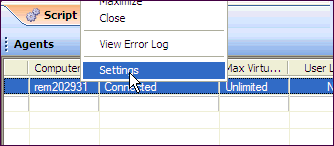BMFAgent.exe is a non-UI agent included with Benchmark Factory. BMFAgent.exe performs the same functionality as Agent.exe, except BMFAgent.exe has no graphic user interface. This allows you to easily integrate BMFAgent.exe into your continuous integration or continuous testing process.
The Windows version of BMFAgent.exe is installed into the bin sub-directory of the installation directory at the time you install Benchmark Factory.
The Linux version of this agent can be installed on a remote Linux machine through the Benchmark Factory Console.
BMFAgent.exe has a smaller footprint (file size) than Agent.exe.
Because BMFAgent.exe has the same functionality as Agent.exe, Benchmark Factory uses BMFAgent just as it would Agent.exe. Review the following for additional information.
To Start BMFAgent.exe (Windows)
Open the installation directory. The default installation path is
C:\Program Files\Quest Software\Benchmark Factory <version>
When BMFAgent.exe and Agent.exe are installed, default settings are applied, such as the machine name (IP address) and the port number for the Benchmark Factory console to which the agent connects.
Use one of the following methods to modify the BMFAgent.exe settings:
The following parameters are available from the command line.
| Parameter | Description |
|---|---|
| /p <port number> |
Changes the BMFAgent port used to connect to the console Example: BMFAgent.exe /p 2345 |
| /c <console name/ip> |
Changes the console machine name/ip to which the Agent connects Example: BMFAgent.exe /c myservername |
| /s |
Automatically shuts down the Agent when the job is finished Example: BMFAgent.exe /s |
Using the maximum number of users on an Agent provides better utilization of machine configuration. For example, you can run one machine with ten users and another with 100 users. This allows light-weight machines to be used with more powerful machines.
To specify Maximum Virtual Users
Right-click the agent in the Agent pane of the Benchmark Factory Console and select Settings.

In order to install remote agents through the Benchmark Factory console, you need to turn off the firewall or configure the firewall to allow traffic between the console machine and the agent machine. To allow traffic thru the firewall, enable Windows Management Instrumentation (WMI) and open TCP port 135 on the agent machine.
In addition, after the remote agent is installed, the Benchmark Factory console and the remote agent also communicate through port 4568 (by default). To enable this communication, configure an inbound rule on the console machine and an outbound rule on the agent machine.
Note: The console and remote agent communicate through port 4568 by default. You can change this port number in Edit | Settings | General. Check this setting to ensure you use the specified port number when creating inbound/outbound rules.
Enable Windows Management Instrumentation (WMI) to allow communication between the Benchmark Factory console and the remote agent. The following instructions are applicable to Windows 7. For more information, see http://msdn.microsoft.com/en-us/library/aa822854(v=vs.85).aspx.
To enable WMI (Windows 7)
The Benchmark Factory console uses TCP port 135 to start agents remotely, and port 4568 is used by the console and the agent machine for communication. Create inbound and outbound rules to allow port 135 and port 4568 traffic through the Windows Firewall.
Create Inbound Rule on console machine
Create Inbound Rule on agent machine
Create Outbound Rule on agent machine (if outbound connections are blocked)
If outbound connections are allowed, then no action is required.
Note: In Windows Firewall, outbound connections are set to “Allow” by default.
After enabling WMI and configuring inbound/outbound rules, if you encounter an error while attempting to install a remote agent because you are denied access, try the following.
Add a Registry key (Windows 7, Windows 8)
Open the Registry Editor (regedit.exe).
Caution: Editing your Registry incorrectly can cause serious, system-wide problems. It is advised that you back up your Registry before modifying it.